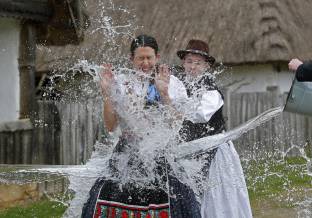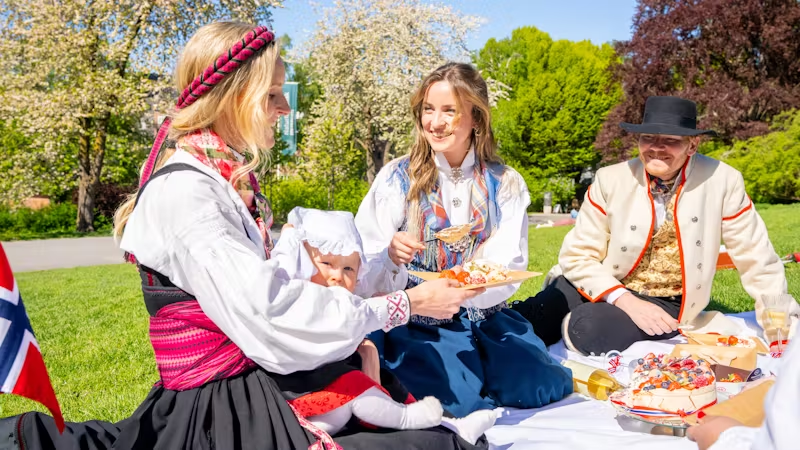In addition to its stunning landscapes, tumbling fjords, and energetic towns, Norway is home to a rich cultural legacy steeped in long-standing customs. Norway's traditions, which have shaped the identity of its people throughout the ages, range from Norse rites to traditional norwegian culture key words.
Let's explore the rich tapestry of Norwegian customs, learning about everything from well-liked pastimes to Norwegian festivals, food, and social mores. To help you discover more about the intriguing Norwegian culture, here are 20 of the country's most well-known customs.
Iconic Symbols of Norwegian Heritage
![]()
Outdoor life is so central to Norwegian culture that it is enshrined in Norwegian legislation as the "right to roam," which guarantees everyone the freedom to explore the natural world. Engaging in enjoyable outdoor pursuits like cycling, hiking, kayaking, and skiing is ingrained in Norwegian culture and traditional norwegian culture key words.
Many Norwegian youngsters go on woodland excursions and paddle in the country's stunning waterways with their parents or other caregivers. This ignites a passion for the natural world that lasts from childhood into maturity and is eventually passed on to the following generation.
Read Also: Pop Culture Fashion Explored: What You Need To Know?
Culture of Cabins: Comfortable in the Woods
If you're asking, "What is the culture of Norway?" cabin culture is actually a major aspect of Norwegian culture. Norwegians enjoy to curl up in cottages by the sea, in the mountains, or in the forests. A lot of Norwegians consider their cabins to be a second home, which makes it simple and convenient for them to spend time in nature. Cabins are frequently inherited by families.
Cabins, called "hytte" in Norwegian, are the ideal spot to unwind after a day of skiing in the mountains or wandering through the forest. Due to the abundance of cabins that are available for rent as holiday rentals around Norway among breathtaking scenery, visitors may also experience a little of cabin culture.
Pickled Herring for Breakfast, Straight From the Sea
Norway is a coastline country, thus eating fresh fish and seafood is very important to Norwegian culture. The custom of eating pickled herring for breakfast is one of the cultural customs of Norway that may surprise you. In Norway, herring is a popular fish that is typically pickled and salted in households before being served at the morning table with bread and brown cheese.
A cup of porridge with some pickled herring on top was a typical Norwegian meal during the Victorian era. These days, it's typically consumed as part of a savory meal; classic pickled herring is often served in the morning with slices of onion and caviar.
A Mainstay of Norwegian Culture: Camping
It should come as no surprise that camping is a popular activity among Norwegians because of their love of the outdoors and nature. As long as you remain for only one night, leave the place in the same state that you found it, and are at least 150 meters away from any structures, camping is permitted practically anywhere in Norway.
With a whole nation full of stunning scenery, including woods, fjords, mountains, and coastlines, Norwegians are sure to find plenty of amazing places to camp! In addition to the classic tent camping, campervan travel is another really well-liked method to experience Norway.
A Tapestry of Flags, Parades, and Celebrations on Norway's National Day
Norway's National Day, celebrated on May 17th, is a joyous occasion commemorating the signing of the nation's constitution in 1814 and is one of the largest festivals and customs in Norway. Instead of military demonstrations, Norway's National Day is marked by a strong sense of community, in contrast to many other countries.
Children's parades kick off the day, with local and national flags being proudly displayed by schools, marching bands, and community organizations. In celebration of Norwegian history and culture, people of all ages gather, eat a ton of ice cream, and the streets are decked up in the red, white, and blue Norwegian flag.
Bunads: Symbolic Clothes Bridging Generational Divides
Depending on the location and gender, the bunad, a traditional Norwegian costume, has different designs, colors, and ornaments. One important and symbolic custom that links people to their local background and ancestry is wearing a bunad on Norway's National Day in May.
The bunad's elaborate needlework, designs, and hues can capture the unique customs of a certain region. Wearing their bunads on important events like weddings, confirmations, and, of course, Norway's National Day is something that many Norwegians take great pleasure in.
Sami Customs: Accepting Native American Culture
The indigenous Sami people, who live in Norway, have traditions and rituals that are deeply ingrained in Norwegian society. Northern Scandinavia is home to the Sami people, who are renowned for their unique attire, language, and nomadic way of life.
The founding of the first Sami Parliament in 1917 is commemorated on February 6th, the annual Sami National Day. Sami art and crafts are on display, together with cultural events and traditional performances, to commemorate this day. The celebration of reindeer herding, a traditional Sami source of income, emphasizes the value of maintaining indigenous customs in modern society.
One of Europe's Oldest Musical Traditions: Joik
A joik is a distinctive style of musical expression done by the Sami people and is said to be among the oldest musical traditions on the European continent. This folk music genre has some parallels to the music of Siberian shamans, which frequently imitates the sounds of nature, and frequently consists of very personal and spiritual songs.
According to legend, the Sami people received joiks as gifts from elves and Arctic fairies. Despite the fact that joik is an old art form that has been passed down from generation to generation, its past is unknown since the Norwegian native culture of the Sami people lacks a written language.
Norway's national beverage is aquavit.
Aquavit, the distilled spirit that is Norway's national beverage, was initially made in the 15th century and possesses a remarkable 40% alcohol by volume. Aquavit is frequently used at well-known Norwegian customs and festivities, such Christmas and Midsummer, and is frequently flavored with caraway spices and occasionally dill.
The Latin aqua vitae, which means "water of life," is where the word aquavit originates! While other Scandinavian nations manufacture aquavit from grains, which results in a light-colored or even transparent beverage, Norwegian aquavit is prepared from potatoes and is frequently yellow.
Trolls: The Significance of Norse Legends
Because they have captivated Norwegians' attention for ages, trolls hold a significant cultural position in Norway. These fantastical creatures from Nordic folklore are frequently featured in sagas, fairy tales, stories, and myths. They are described as magical entities that live in caves and avoid human interaction, but when they do, they are not the most helpful!
According to certain myths, trolls are responsible for a variety of hazardous meteorological and geological phenomena, including rock falls and blizzards. People thought that because sunlight would turn trolls to stone, they never went outside during the day. Trolltunga, which translates to "troll's tongue," is a well-known hiking trail in Norway since trolls are such an essential part of the country's history and culture.
Kos: Hygge in Norway's Version
Hygge, a Danish concept that emphasizes comfort, warmth, and soul-nourishing items, may be familiar to you. Kos is Norway's take of hygge, which emphasizes slowing down, being thoughtful, and traditional norwegian culture key words.
Kos embodies many of the traditional Norwegian values of appreciating the small things in life, like a warm fire or a breathtaking fjord view when hiking with a special someone. Kos is a fantastic idea to keep in mind if you want to get the most of your fantastic road trip in Norway.
Dugnad: Volunteering in the Community
A dugnad symbolizes the value of the group and community in Norwegian culture and customs, since it is a common practice to gather together to clean, repair, paint, and organize an apartment complex or housing estate. To support their local community, schools and other clubs organize a dugnad, which is often held in May on Norway's National Day.
These local volunteer events, which have been around for centuries, typically entail hard work and serve to unite people in order to make a difference. Dugnads are being practiced today and are perhaps the healthiest of all Norwegian customs!
Julebord: Norwegian-Style Christmas Celebrations
In Norway, Christmas is a wonderful season with many rituals that combine old-world traditions with contemporary festivities. A julebord is a community dinner that has been a part of Norwegian culture for generations and is considered one of the greatest for foodies. The joyful feast known as Julebord, or Christmas table, usually occurs in the weeks preceding Christmas. Colleagues, friends, and family get together at this time to enjoy a range of traditional foods.
The Julebord meal frequently includes pinnekjott (cured and dried lamb), ribbe (roast hog belly), lutefisk (dried fish), and a selection of seasonal sweets. Traditional decorations and music contribute to the celebratory mood, which is one of warmth and companionship.
Janteloven: The Social Codes of Norway
In reality, Janteloven, often known as the Law of Jante, is a fictional social code or system of rules governing social attitudes that explains why Norwegians behave in certain ways. In Scandinavia, the value of the group above the individual is reflected in these laws.
Being supportive of and praising the community and society rather than being envious of others or bragging about personal triumphs is a fundamental component of janteloven. In fact, some Norwegians think that janteloven is preventing their nation from embracing startup culture and realizing its full potential internationally.
The Antithesis of Fast-Paced Consumption: Slow TV
Slow TV, another of Norway's coziest customs, focuses on slow, calming, and engaging daily programming. For instance, one program included the breathtaking scenery along the Oslo-Bergen train line in real time, while another featured a more than 130-hour ship ride along the Norwegian coast!
Other slow TV broadcast examples highlight significant aspects of Norwegian culture and customs, including a National Knitting Night that includes knitting debates and hours of live sheep shearing—how adorable!
Must Know: How Does Culture Impact Fashion?
Midsummer Festivities: Accepting the Sun at Midnight
"Sankthansaften," or midsummer, is a celebration of the summer solstice and Norway's long days of sunshine, which include the breathtaking Midnight Sun. Midsummer celebrations, which were once connected to archaic rites, have evolved into a time for happiness and outdoor pursuits.
Lighting bonfires along the coast, lakeshores, and hilltops during the midsummer season is the most significant cultural practice in Norway and represents the expulsion of bad spirits. In order to embrace the beauty of the Norwegian summer, families and friends get together for picnics, sports, and traditional dances. This fosters a sense of joy and solidarity.
Easter Traditions: A Combination of Folk and Religious Practices

In Norway, Easter combines ancient traditional traditions with Christian celebrations. Reading crime books over the holiday is part of the "Easter crime" custom, and several television networks play crime dramas around this time to fit in with the theme.
Decorating eggs is one of the most treasured Easter customs. Eggs with elaborate designs and paintings, sometimes with vivid hues and complex patterns, are showcased as representations of rebirth and new life. During the Easter holiday, families often take advantage of the burgeoning springtime by going hiking and skiing.
Contemporary Festivals: Blending Local and Global Influences
Norway is a contemporary, vibrant culture that welcomes a wide variety of influences, despite its deep historical roots. Norway's thriving modern music industry is on display at music events like the Trondheim Calling Festival and Oslo's Oya Festival.
This rich cultural tapestry combines Norwegian traditions and customs with international trends through food festivals, literary gatherings, and art exhibits. These occasions show how Norway may preserve its culture while actively participating in the changing global community.
Take a Look at Norway's Diverse Cultural Traditions!
Norwegian customs and traditions, which combine aspects of Christian influences, indigenous Sami culture, old Norse rites, and contemporary festivities, provide a feeling of common heritage and a link between the past and the future. Norwegians continue to embrace and celebrate the various aspects that make their cultural heritage genuinely distinct, whether they are taking part in a Julebord feast, wearing vibrant bunads, or enjoying a Midsummer campfire.
FAQs
What is the Norwegian greeting culture?

"Hello" in Norwegian can be either "hallo" or "hei," and both are as acceptable and interchangeable. There are several variants on this, and "heihei" or "heisann" are frequently used. This is "god morgen in" if you want to say "good morning."
What is traditional in Norway?
A Tapestry of Flags, Parades, and Celebrations on Norway's National Day. Bunads: Generation-Uniting Symbolic Clothes. Sami customs: Accepting Native American culture. One of Europe's oldest musical traditions is the traditional norwegian culture key words. Norway's national beverage is aquavit.
What is the Norwegian culture known for?
Many Norwegians wear traditional clothes, or bunad, on important occasions, and they have a strong sense of civic involvement and history. Tolerance, equality, and respect are among the most significant ideals in Norwegian culture. Norway is a study abroad destination. Take in a Norwegian student in the United States.





